AMPK Helps Reduce Abdominal Fat
In their search for natural compounds to extend the human lifespan, scientists have focused on ways to activate an enzyme called AMPK.
AMPK is found inside every cell and serves as a master energy sensor. Its activity level influences body fat composition and how long you’ll live.
During their investigations, scientists discovered that boosting AMPK resulted in an unexpected benefit: the reduction of abdominal fat.
Their findings made sense. Here’s why. As we age, cellular AMPK activity decreases and as a result, weight gain often follows.1-3
Excess weight, particularly in the abdominal region, accelerates aging processes.4 Boosting AMPK activity results in a healthier metabolic status, which can lead to less fat production.5,6
These findings were recently confirmed in a pair of human clinical trials. Researchers activated AMPK using two natural compounds. The result was a significant drop in abdominal fat.
The first study showed that abdominal fat deposits fell by 11%.7 In the second study, scientists observed a significant reduction in harmful inflammation, which can contribute to weight gain.8
For a nation where almost 75% of the population is overweight and obese, this is important news.9
While most people are interested in the cosmetic allure of reducing belly fat; the true value will be in the lives saved from the illnesses caused by abdominal adiposity.
This article reveals the science behind two plant extracts that boost AMPK activity and their ability to help reduce abdominal fat load.
Not all body fat is the same. Certain types, such as abdominal fat, pose the greatest threat.
While abdominal fat is unsightly, it is also dangerous and can speed up aging processes.10 Deep abdominal fat morphs into its own organ, becoming an inflammation-promoting factory.11
The more abdominal fat you carry, the more inflammatory chemicals are produced that attack your body and produce more fat. Once this vicious cycle begins it is difficult to stop without a targeted intervention.
Inflammation underlies much of the tissue damage that causes organ dysfunction. The end result is degenerative disorders that include dementia, diabetes, cardiovascular disease, certain cancers, and potential bone and joint breakdowns.7,12-17
Increasingly, clinicians and patients are recognizing that the antidiabetes drug metformin has favorable effects on abdominal fat as well as on biomarkers of chronic inflammation induced by those fat deposits.18,19
Metformin’s best-studied mechanism of action is to promote the activation of a master metabolic regulator in cells, called AMPK.19 As a prescription drug, metformin may be difficult to obtain by nondiabetics. Physicians are reluctant to promote the tremendous “off label” benefits of metformin.
Fortunately, researchers have identified two natural compounds that have been shown to activate AMPK, enabling many of the same systemic benefits as metformin. And, like metformin, the reduction of harmful abdominal fat is one of those benefits.
Let’s review the two groundbreaking studies on Gynostemma pentaphyllum and hesperidin, to see how this combination offers a two-pronged approach to reducing abdominal fat.
What You Need to Know
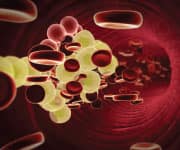 |
AMPK Targets Abdominal Fat
- AMPK activity decreases with age.
- Studies show that activating AMPK not only reduces abdominal fat, but also reduces the inflammation and other damage that it wreaks.
- Metformin is a well-known AMPK activator but requires a prescription, and many people cannot tolerate its gastrointestinal side effects.
- Gynostemma pentaphyllum reduces abdominal fat in overweight adults that were otherwise healthy.
- Hesperidin, a flavonoid molecule derived from citrus, acts in a complementary fashion to slash markers of inflammation while boosting blood-vessel function and lowering cardiovascular risks.
- G. pentaphyllum extracts and hesperidin are now available to help activate AMPK to reduce abdominal fat and its deadly inflammatory, cardiovascular, and metabolic risk-raising impact.
Gynostemma Pentaphyllum
The medicinal herb Gynostemma pentaphyllum has been shown in animal studies to be an effective AMPK activator.20,21
G. pentaphyllum has long been used in traditional Chinese medicine to treat metabolic problems including elevated lipids, fatty liver, and, in particular, obesity.20-22
Biochemists have determined that G. pentaphyllum extracts are powerful activators of AMPK, making them appealing in the quest to reduce abdominal obesity by shutting down fat production and accelerating fat burning.23
Boosting Cellular AMPK Confers Powerful Anti-Aging Effects
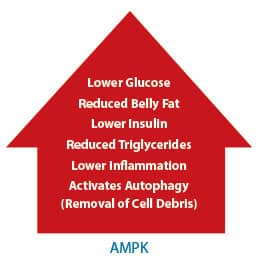 |
Aging cells suffer diminished AMPK (adenosine monophosphate activated protein kinase). AMPK decline is heavily involved in degenerative aging. In time of famine, AMPK increases, which slows cells proliferation and prompts efficient utilization of stored fat. Modern populations consume an abundance of calories and suffer chronic suppression of AMPK. This can result in malignant cell transformation, accelerated aging, and excess fat storage. Those consuming typical modern diets should proactively boost their AMPK activity.
Human Study
Based on initial findings, researchers conducted a human randomized, placebo-controlled trial of a G. pentaphyllum extract for reduction of abdominal obesity.
In this study, 80 overweight people with a body mass index (BMI) between 25 and 30 kg/m2, were randomly assigned to receive the G. pentaphyllum extract, 450 mg/day, or a placebo, for 12 weeks.7 Participants in both groups continued their usual diets.
In order to rigorously determine the effectiveness of the G. pentaphyllum extract, the participants’ abdominal fat area and distribution was measured with a CT scan at the beginning and at the end of the study. Body weight, BMI (body mass index), percent body fat and lean body mass were also measured and recorded.
The study found that during the 12 weeks of supplementation, total abdominal fat area, body weight, body-fat mass, percent body fat, and body-mass index were decreased in the supplemented subjects compared to placebo recipients.7
Total fat area fell by 6.3% in supplemented subjects, but by less than 1% in placebo recipients, and the all-important abdominal fat deposits fell 11% vs. 3%. Subcutaneous fat dropped in supplemented subjects by nearly 4%, while increasing slightly in the placebo group.
This human study demonstrated the fat-reduction effects produced by G. pentaphyllum extract.
We now turn to a citrus extract which has the complementary effect of reducing fat-produced inflammatory factors that make abdominal fat so dangerous.
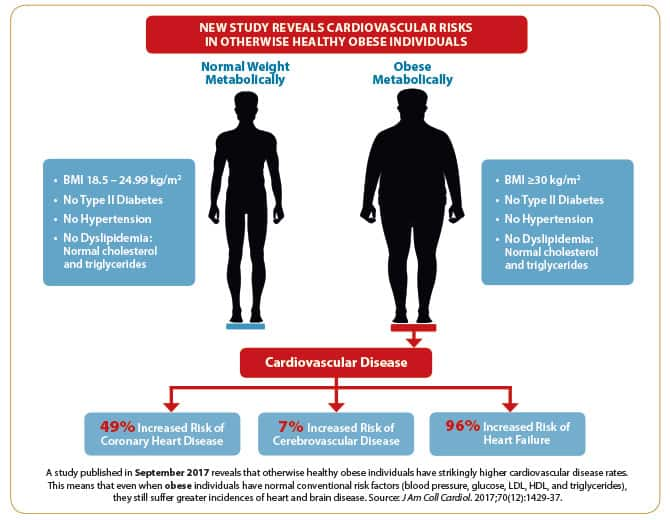
Hesperidin Slashes Inflammatory Markers
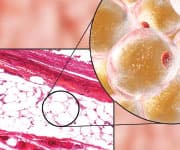
While abdominal fat is unattractive, it is also life-threatening. Abdominal fat generates massive amounts of inflammation-promoting cytokines.
These inflammatory cytokines cause serious damage to blood vessels, heart muscle, brain cells, and other tissues throughout the body.24
Substances produced by the active fat cells, especially in abdominal fat, also contribute to endothelial dysfunction, which can result in reduced blood flow and higher blood pressure.24-26 Endothelial dysfunction is a known early finding in atherosclerosis and ultimately heart attacks, strokes, and other cardiovascular disasters.25,26
In one clinical study, when healthy volunteers deliberately gained on average 4 kg (8.8 pounds) over eight weeks, endothelial function worsened by more than 14%. Interestingly, this decline was completely reversed when the subjects lost the excess weight they’d gained.25
Another adverse effect of carrying around too much abdominal fat was shown in a laboratory study. The scientists noticed that blood vessels from subjects with large abdominal fat deposits had reduced nitric oxide, the signaling molecule that tells arteries to relax and dilate, improving blood flow and pressure.24
This indicates that any compound that reduces markers of fat-induced inflammation and improves other cardiovascular risk factors is an ideal complement to Gynostemma pentaphyllum’s abdominal fat-reducing properties.
Researchers at the National Center for Complementary and Alternative Medicine at the National Institutes of Health and several universities worldwide studied the citrus-derived flavonoid, hesperidin, which is a candidate for that complementary role.
In the first part of their study, the scientists treated cells in culture with hesperetin, the form of hesperidin that is absorbed into the bloodstream after ingestion.8 They found that this treatment promoted AMPK activation.
Having demonstrated these beneficial effects, the researchers conducted a randomized, placebo-controlled, double-blind study in a group of people with metabolic syndrome, which has as one of its characteristics increased abdominal fat and its inflammatory consequences.8
Subjects took either a placebo pill or 500 mg hesperidin once daily for three weeks. They were monitored and measured for endothelial function, metabolic parameters, and markers of inflammation at baseline and after the treatment period. Subjects continued their usual diet and physical activity patterns during the study.
The study found a significant reduction from baseline in blood levels of C-reactive protein, a validated measure of overall inflammation in the body. This study showed that compared to baseline, there was a 33% decrease in C-reactive proteinin the hesperidin supplemented group.
In hesperidin-treated subjects, the flow-mediated dilation test demonstrated an associated treatment effect (improvement) of approximately 29% in comparison with placebo.8 That indicates AMPK-induced improvements in vascular function which may counteract the abdominal fat-induced degradation of arterial function.
Finally, the study showed that the hesperidin group had a significant improvement in a cholesterol carrier associated with increased risk of heart disease called ApoB.8,27,28
This study makes a strong case for hesperidin, with its anti-inflammatory, provascular health properties, as a perfect complement for the abdominal fat reduction produced by G. pentaphyllum extract.
Evidence from previous studies shows that hesperidin may contribute directly to abdominal fat reduction. In one clinical trial, obese subjects taking hesperidin showed modest reductions in abdominal fat comparable to those seen in a study of metformin, which is a potent AMPK activator.18,29
How AMPK Removes Cellular Debris and Reduces Abdominal Fat
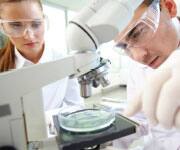 |
As part of normal energy production, our cells “clean house” by a process known as autophagy.30 This is how cells clear damaged proteins, dysfunctional mitochondria, viruses, and other metabolic waste products. Research shows that when autophagy declines, premature aging accelerates.31,32 Restoring healthy autophagy is a critical factor to slow and reverse biological aging.33 Scientists have discovered that autophagy can be increased by boosting AMPK.34,35 Activated AMPK signals cells to remove internal pollutants.33,36 For many people, helping their cells remove debris via AMPK activation may result in reduced abdominal fat.7
An in depth report on how AMPK removes toxic cellular debris will appear in the February 2018 edition of Life Extension Magazine®.
Summary

While obesity poses serious threats, excess belly fat is the most dangerous. Fat accumulations inside the abdomen represent real dangers in terms of health and longevity.
A major contributor to abdominal fat buildup is the age-related decline in AMPK, an enzyme that helps regulate fat storage.
Activated AMPK triggers beneficial effects such as a reduction in fat deposition. The marked decline in AMPK that occurs with aging results in increased fat and destructive metabolic consequences.
The prescription drug metformin can boost AMPK activation, but metformin is not available for everyone. That’s why scientists have become so excited by two natural compounds that can activate AMPK and battle belly fat.
Extracts of Gynostemma pentaphyllum reduced deadly abdominal fat accumulations in people with abdominal obesity and metabolic syndrome.
And the citrus flavonoid hesperidin produced complementary reductions in inflammation, and improvements in blood-vessel performance, all of which help to further mitigate the problems associated with abdominal fat.
Together, these two compounds provide a dual-action approach to reducing problematic abdominal fat.
By Sonia Whitman
Article extracted from Life Extension Magazine


Social Login